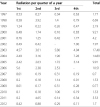1. Chen Y, Wang H, Kantarjian H, Cortes J. Trends in chronic myeloid leukemia incidence and survival in the United States from 1975 to 2009. Leuk Lymphoma. 2013; 54(7):1411–1417. DOI:
10.3109/10428194.2012.745525. PMID:
23121646.
2. Cardis E, Gilbert ES, Carpenter L, Howe G, Kato I, Armstrong BK, Beral V, Cowper G, Douglas A, Fix J, Fry SA, Kaldor J, Lave C, Salmon L, Smith PG, Volez GL, Wiggs LD. Effects of low doses and low dose rates of external ionizing radiation: cancer mortality among nuclear industry workers in three countries. Radiat Res. 1995; 142(2):117–132. DOI:
10.2307/3579020. PMID:
7724726.
3. Preston DL, Kusumi S, Tomonaga M, Izumi S, Ron E, Kuramoto A, Kamada N, Dohy H, Matsuo T, Nonaka H, Thompson DE, Soda M, Mabuchi K. Cancer incidence in atomic bomb survivors. Part III. Leukemia, lymphoma and multiple myeloma, 1950-1987. Radiat Res. 1994; 137:S68–S97. DOI:
10.2307/3578893. PMID:
8127953.
4. Pierce DA, Shimizu Y, Preston DL, Vaeth M, Mabuchi K. Studies of the mortality of atomic bomb survivors. Report 12, Part I. Cancer: 1950-1990. Radiat Res. 1996; 146:1–27. DOI:
10.2307/3579391. PMID:
8677290.
5. Moysich KBMR, Michalek AM. Chernobyl-related ionising radiation exposure and cancer risk: an epidemiological review. Lancet. 2002; 3:269–279. DOI:
10.1016/S1470-2045(02)00727-1. PMID:
12067803.
6. Cogliano VJ, Baan R, Straif K, Grosse Y, Lauby-Secretan B, El Ghissassi F, Bouvard V, Benbrahim-Tallaa L, Guha N, Freeman C, Galichet L, Wild CP. Preventable exposures associated with human cancers. J Natl Cancer Inst. 2011; 103(24):1827–1839. DOI:
10.1093/jnci/djr483. PMID:
22158127.
8. Nuclear safety and security commission of Korea: Regulation on the Evaluation and Management of Personal Radiation Exposure. Notification 2013-39.
9. Lim HS, JY , Jeong MS, Lee BI, Cho DH, Oh JJ, Kim JI, Jeong C, Lee K. A Study of the Modification on Guidelines for Occupational Diseases Among Radiation Exposed Workers. 2004.
10. Choi KH, Ha M, Lee WJ, Hwang SS, Jeong M, Jin YW, Kim HJ, Lee KY, Lee JE, Kang JW, Kim H. Cancer risk in diagnostic radiation workers in Korea from 1996-2002. Int J Environ Res Public Health. 2013; 10(1):314–327. DOI:
10.3390/ijerph10010314. PMID:
23343985.
11. Jeong MS, JY , Lim HS, Kim CS. Use of screening dose to evaluate the work-relatedness of cancers occurring among Korean radiation workers. Korean J Occup Envrin Med. 2007; 3(19):196–203.
12. Davies HE, Wathen CG, Gleeson FV. The risks of radiation exposure related to diagnostic imaging and how to minimise them. BMJ. 2011; 342:d947. DOI:
10.1136/bmj.d947. PMID:
21355025.
13. Vaño E, Gonzalez L, Fernandez JM, Alfonso F, Macaya C. Occupational radiation doses in interventional cardiology: a 15-year follow-up. Br J Radiol. 2006; 79(941):383–388. DOI:
10.1259/bjr/26829723. PMID:
16632618.
14. Meeseon Jeong Y-W, Kim CS. Program for estimating the probability of causation to Korean radiation workers with cancer. J Korea Asso Radiat Prot. 2004; 29(4):221–230.
15. Korea Centers for Disease Control and Prevention Division of Health & Nutrition survey Medical Radiation T/F: 2012 report occupational exposure in diagnostic radiology. Report of Korean Center for Disease Control and National Dose Registry of Korea, 2013:1-40.
16. E-a K. Occupational diseases of health care workers. Hanyang Med Rev. 2010; 30(4):265–273. DOI:
10.7599/hmr.2010.30.4.265.
17. Ahn YS. Occupational malignant lymphohematopoietic diseases compensated under the industrial accident compensation insurance from 1996 to 2005. Korean J Occup Environ Med. 2007; 19(2):81–92.
18. Kocher DC, Apostoaei AI, Henshaw RW, Hoffman FO, Schubauer-Berigan MK, Stancescu DO, Thomas BA, Trabalka JR, Gilbert ES, Land CE. Interactive RadioEpidemiological Program (IREP): a web-based tool for estimating probability of causation/assigned share of radiogenic cancers. Health Phys. 2008; 95(1):119–147. DOI:
10.1097/01.HP.0000291191.49583.f7. PMID:
18545036.









